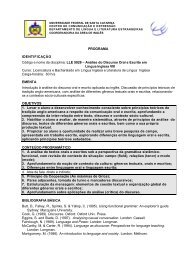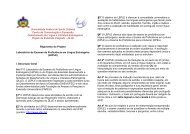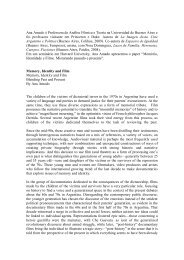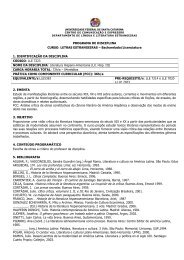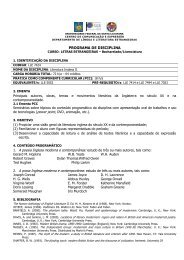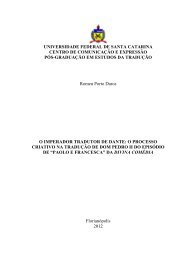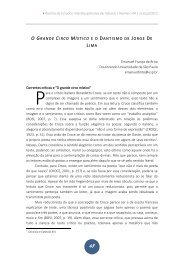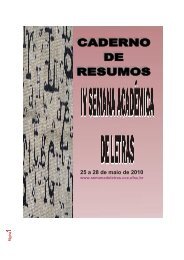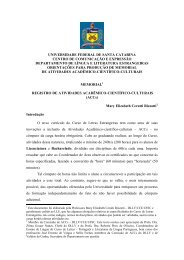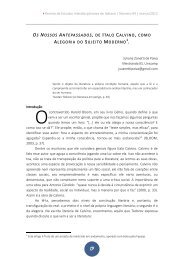You also want an ePaper? Increase the reach of your titles
YUMPU automatically turns print PDFs into web optimized ePapers that Google loves.
VÁZQUEZ – DESPUÉS DEL FIN DEL ARTE: COPIviously, this work cannot replace a proper study that would require a <strong>de</strong>epand systematic investigation; nevertheless, I un<strong>de</strong>rstand that it can establishsome productive axes for future analyses. This paper tries, on one hand, toanalyze the comic production of an author which was published in differentgraphical media, taking a broad view over a period that starts in his politicalexile and ends in a breakthrough in his artistic trajectory. Finally, it is possibleto stand out that the graphical work of the author is fundamental not onlyto <strong>de</strong>epen the studies about comics and strips but also to think amplersubjects. In other words: his production is peculiar not only because it allowsthe analysis of a type of particular allegory, but because in that samegesture, it transcends itselfKeywordsComics - Art - Exile - Politics - IndustryPOR QUÉ COPISi yo escribo sobre la Argentina,escribo también sobre Yugoslavia.CopiEn este artículo parto <strong>de</strong> la perspectiva <strong>de</strong> que las historietas se ubicanen un cruce singular entre masividad y marginalidad, entre visibilida<strong>de</strong> invisibilidad y entre legitimidad e ilegitimidad, lo que constituyeen la industria cultural y masiva una particularidad relevante.De manera representativa, la producción artística <strong>de</strong> Raúl Damon<strong>de</strong>Taborda (Copi) da cuenta <strong>de</strong> una serie <strong>de</strong> tensiones entre el arte y elgénero, entre la cultura <strong>de</strong> masas y la cultura popular pero tambiénentre lenguaje y estética ya que su obra se resiste a la clasificación.Des<strong>de</strong> esta premisa, la importancia central que supone analizar la obrahistorietística <strong>de</strong> Copi parte <strong>de</strong> su singularidad en el campo <strong>de</strong> la narrativadibujada. 1 Antes conviene <strong>de</strong>stacar, que el análisis <strong>de</strong> la especificidad<strong>de</strong>l lenguaje historietístico y <strong>de</strong> sus cruces con otros medios narrativos,se encuentra aún muy poco <strong>de</strong>sarrollado frente a otras áreas <strong>de</strong>l1Me refiero al “campo <strong>de</strong> la historieta argentina”, utilizando la categoría sociológica<strong>de</strong> Pierre Bourdieu. En tanto sistema <strong>de</strong> posiciones y <strong>de</strong> relaciones objetivas entre lasmismas, el campo, en sentido general, asume una existencia temporal, lo que implicaintroducir la dimensión histórica en el análisis. (Bourdieu, 1988) Los campos socialespresentan una serie <strong>de</strong> propieda<strong>de</strong>s generales y comparten reglas <strong>de</strong> funcionamientoentre sí. De allí que resulte productivo analizar el campo <strong>de</strong> la historieta en relación ados campos cercanos en el espacio social: el campo artístico y el campo editorial. Elinterés es dar cuenta <strong>de</strong> distintas luchas por conservar o transformar el sentido <strong>de</strong>ljuego. Entiendo que la tensión entre el arte y el mercado pue<strong>de</strong> reconstruirse <strong>de</strong> maneraeficaz a partir <strong>de</strong> sus vínculos relacionales. Por último, quiero <strong>de</strong>stacar que altomar esta categoría para hacer referencia al espacio <strong>de</strong> producción, circulación y consumo<strong>de</strong> historietas, he tenido en cuenta, al mismo tiempo, la advertencia <strong>de</strong> Carlos Altamiranoy Beatriz Sarlo, quienes han subrayado las limitaciones que tienen los conceptos<strong>de</strong> Bourdieu para el estudio <strong>de</strong> las socieda<strong>de</strong>s latinoamericanas (Altamirano y Sarlo,1983).3839



